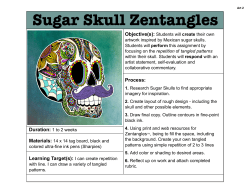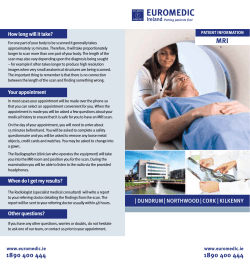
REVIEW ARTICAL Medical Science How to read a Computed Tomography scan for
Volume :2/ issue : 1/ Jan –June 2013 REVIEW ARTICAL Medical Science How to read a Computed Tomography scan for traumatic brain injury in emergency room Dr.Amit Agrawal* *Professor of Neuro Surgery, Dept of Neuro Surgery Narayana Medical College & Hospital, Nellore-524002(AP) India Email :-dramitagrawal@gmail.com Abstract CT brain is the integral part of investigation in any case of cranio-cerebral trauma patient in emergency room. It is an extremely useful diagnostic tool that is used routinely in the care of trauma patients in emergency department. It has been suggested that even a brief educational effort of these persons can provide considerable proficiency to interpret cranial CT scans. With an increasing role of dental experts in the management of craniofacial trauma patients it is anticipated that it would be helpful to know how to read a CT scan of a suspected traumatic brain injury patient in an emergency department. It is important to recognize and familiarize with the normal appearance of different anatomical parts of the brain on CT scan (Cerebral, cerebellum, brain stem, ventricles and skull bones etc.). The present article discusses the basic s of CT scan and provides a pictorial presentation of commonly seen intracranial lesions in patient with traumatic brain injury. Key words CT scan, traumatic brain injury, skull fracture, head injury. 2 Volume :2/ issue : 1/ Jan –June 2013 8 Introduction as 0 HU. Computed tomography (CT) of the brain is sequential manner will help to avoid or miss an extremely useful diagnostic tool that is even subtle abnormalities on imaging. used routinely in the care of trauma patients Systemic collection also will 1 Reviewing all the structures in a 8 help to It has been identify abnormalities and deviations from shown in many studies that the caregivers in the normal pattern. CT scan can be learned the emergency department can have a by following stepwise approach (Table-1). 3 in emergency department. deficiency to interpret brain CT scans.2-7 However, at the same time it has been suggested that even a brief educational effort of these persons can provide considerable proficiency to interpret cranial CT scans.3, 4 With an increasing role of dental experts in the management of craniofacial trauma patients it is anticipated that it would be helpful to know how to read a CT scan of a suspected traumatic brain injury patient in an emergency department. The present article discusses the basic s of CT scan and provides a pictorial presentation of commonly seen intracranial lesions in patient with traumatic brain injury. Basic principles It is important to recognize and familiarize with the normal appearance of different anatomical parts of the brain on CT scan (Cerebral, cerebellum, brain stem, ventricles and skull bones etc.). Based on their density different structures can appear as white (+1000 HU e.g. bone) or black (-1000 HU e.g. air). 8 The density of water is described 3 Volume :2/ issue : 1/ Jan –June 2013 Table-1 Summary of systematic approach to read a CT scan Parameter Significance Name To correctly identify the person Date Will help to follow up the findings and also help to define the age of injury Orientation Right versus left Approach It may from inside-out It may be cranial-caudal It may be problem based Slicing Axial Coronal Sagittal Windowing Identify the contents and structures Bone window Tissue window Subdural window Brain parenchyma (any hemorrhage or abnormal appearance) Bones (any fractures) Skull and facial bones Orbits Orbital walls Maxillary alveolus Nasal septum Ventricles (symmetry or any presence of blood) Cisterns (any evidence of mass effect or presence of blood) Sinuses (any fluid or hemorrhage) Frontal Sphenoid Ethmoid sinuses Maxillary sinuses Mastoid air cells Cerebrospinal fluid (any evidence of subarachnoid hemorrhage) Blood Acute hemorrhage appear hyperdense (50 to 100 HU) Location of the blood (please see epidural hematomas, subdural hematomas, intraparenchymal hemorrage, and subarachnoid hemorrhage) Midline shift and mass effect Position of the falx (midline or shift to any side) Symmetry or asymmetry of the ventricles Any loss of cisternal space Look for any effacement of sulci 4 Volume :2/ issue : 1/ Jan –June 2013 Spectrum of pathologies significant Extrdural hematoma (EDH) contributing to the poor prognosis. An extradual hematoma often occurs when Chronic subdural hematoma an impact fractures the skull and also Chronic SDH is also crescent shaped usually associated with a skull fracture. The collection over the cerebral convexity that fractured bone fragment can lacerate the usually follows a more benign course underlying dural artery or dural venous sinus (Figure-3). It is caused by slow oozing after leading to collection of the blood return even a minor head injury. Depending on the 9, 10 underlying brain injury On CT scan EDH age of the lesion, it can be hyperdense, appears as a uniformly hyperdense biconvex isodense or hypodense in appearance. There mass (Figure-1). The areas of hypodensity in may EDH may be due to active bleeding. loculations. Chronic subdural hematoma, in Subdural hematoma contrast with acute subdural hematoma, Subdural hematoma appears as a concavo- usually follows a more benign course than convex acute subdural hematoma. skull and dura. (sickle-or crescent-shaped) be associated septations 9, 10 and Attributed to collection of blood, over the cerebral slow venous oozing after even a minor convexity interhespheric closed head injury, the clot accumulates fissure or along the tentorium).It can be an gradually, allowing time for brain to acute lesion, or a chronic collection and both compensate. can primarily occur from venous disruption Cerebral contusion of surface and/or bridging cortical vessels. 9 These are the most common primary brain Acute subdural hematoma injuries. Cerebral contusions are caused by Acute subdural hematoma occurs due to the impact of brain against bony ridge or a deceleration, rotational dural fold. On CT scan these lesions appear forces resulting in tear of bridging veins. In as ill-defined hypodense area mixed with acute SDH the blood collects in space foci of punctate hemorrhages or edema (sometime in acceleration or between the arachnoid and the dura. 9, 10 On (Figure-4). The common locations for CT scan it appears as concavo-convex cerebral contusions (crescent or sickle shaped) hyperdense (anterior lesion (Figure-2). Because of the severity of region), frontal lobe, dorsolateral midbrain the injury acute SDH can be associated with and inferior part of cerebellum.9, 10 tip, are inferior temporal lobe surface, sylvian 5 Volume :2/ issue : 1/ Jan –June 2013 Intracerebral hematoma ridge and maxillary/ethmoid or sphenoid Traumatic intra cerebral hematomas appear sinuses. as high-density areas on plain CT scan and Penetrating injury produce much less mass effect than their Penetrating injury can lead to skull fracture size (Figure-5). These lesions can appear as and early lesions and can develop in a delayed parenchyma. manner. 9 Based on the location and injury to the Sharp underlying objects or brain bullet fragments can get retained in the brain presentation it can be differentiated from parenchyma (Figure-13 and 14). non-traumatic hemorrhagic lesions. Diffuse axonal injury Subarachnoid hemorrhage Diffuse Traumatic subarachnoid hemorrhage (SAH) acceleration, deceleration and rotational occurs due to rupture of small cortical forces causing shearing of the neuronal surface arteries or veins on the brain. The tissue and it the most common cause of bleeding occurs into the space between the significant pia and arachnoid matter that occurs most Hemorrhages usually involve subcortical commonly over the cerebral convexities. On white CT, traumatic SAH appears as focal high callosum and dorsolateral midbrain regions. density in sulci and fissures or linear 10 hyperdensity in the region of cerebral sulci sustained diffuse axonal injury can be (Figure-6). normal. On CT scan there may be presence Skull fracture of ill-defined areas of high density or Skull fractures can be classified as linear or hemorrhages (Figure-16). depressed (whether the fracture fragments Conclusion are depressed below the level of the skull) CT brain is the integral part of investigation and closed or compound (communicating in any case of cranio-cerebral trauma patient with environment) (Figure-.7-12). Fractures in emergency room. A basic knowledge of are better visualized with bone windows CT scan brain, familiarity with the normal settings. anatomical Fractures lines needs to be axonal injury morbidity matter, is and caused by mortality. internal capsule, corpus CT scan findings in a patient who structures and common differentiated with suture lines. Basilar skull pathological conditions without specialist fractures commonly involve the petrous assistance can help to make decision for those conditions that may require immediate 6 Volume :2/ issue : 1/ Jan –June 2013 action. Brain CT interpretation is like other Left fronto-temporo-parietal acute subdural many skills that can be learned through hematoma continuous exposure, patience, practice, and hyperdense appearance) with mass effect repetition. and midline shit (concavo-convex shape and Figure-3 Figure-1 Left fronto-temporo-parietal chronic Typical appearance of EDH e.g. biconvex subdural hematoma (concavo-convex shape hyperdense lesion (A) right fronto-pareital and isodense appearance) with mass effect region, (B) left parietal region (please note and midline shift. mass effect and midline shift Figure-4 Figure-2 Mixed density lesions (A) left frontal and (B) left posterior temporal region with mass 7 Volume :2/ issue : 1/ Jan –June 2013 effect and midline shift (Cerebral CT scan appearance of diffuse subarachnoid contusions) hemorrhage Figure-5 Figure-7 Hyperdense lesion right frontal region (intracerebral hematoma) with thin acute subdural hematoma right fronto-temporal region with mass effect and midline shift (compare appearance contusions in figure-4) Figure-6 with cerebral Left frontal skull bone fracture with minimal depression both inner and outer tables of calvaria Figure-8 8 Volume :2/ issue : 1/ Jan –June 2013 Fracture of left orbit rim and left frontal Figure-11 bone Figure-9 Significant depressed fracture of mid frontal Skull base fracture (right sphenoid bone) bone Figure-12 Figure-10 Skull base fracture involving anterior cranial Compound fracture of frontal bone with a fossa (note the blood in ethmoid sinuses) large scalp laceration 9 Volume :2/ issue : 1/ Jan –June 2013 Figure-13 Figure-15 CT appearance of diffuse brain injury and diffuse cerebral edema Figure-16 Penetrating injuryinvolving right frontal bone, in bone window (B) note the bone fragment in brain parenchyma Figure-14 Gunshot injury causing depressed fracture of the skull CT scan of a patient with diffuse axonal injury multiple small hemorrhages 10 Volume :2/ issue : 1/ Jan –June 2013 References 1. Fujii K, Aoyama T, Yamauchi-Kawaura C, 9. Newberg AB, Alavi A. Neuroimaging in et al. Radiation dose evaluation in 64-slice CT patients with head injury. examinations medicine; 2003: Elsevier: 136-147. with adult anthropomorphic phantoms. and paediatric British Journal of 10. Seminars in nuclear Dubroff JG, Newberg A. Neuroimaging of Radiology 2009;82:1010-1018. traumatic brain injury. Seminars in neurology; 2008: 2. © Thieme Medical Publishers: 548-557. Gorelick PB, Chatterjee A, Patel D, et al. Cranial computed tomographic observations in multiinfarct dementia. A controlled study. Stroke 1992;23:804-811. 3. Perron AD, Huff JS, Ullrich CG, Heafner MD, Kline JA. A multicenter study to improve emergency medicine residents’ recognition of intracranial emergencies on computed tomography. Annals of emergency medicine 1998;32:554-562. 4. Levitt MA, Dawkins R, Williams V, Bullock S. Abbreviated educational session improves cranial computed tomography scan interpretations by emergency physicians. Ann Emerg Med 1997;30:616-621. 5. Alfaro D, Levitt MA, English DK, Williams V, Eisenberg R. Accuracy of interpretation of cranial computed tomography scans in an emergency medicine residency program. Annals of emergency medicine 1995;25:169-174. 6. Roszler MH, McCARROLL KA, Rashid T, Donovan KR, Kling GA. Resident interpretation of emergency computed tomographic scans. Invest Radiol 1991;26:374-376. 7. Arendts G, Manovel A, Chai A. Cranial CT interpretation by senior emergency department staff. Australasian radiology 2003;47:368-374. 8. Perron A. How to read a head CT scan. Emergency Medicine 2008:753-763. 11
© Copyright 2025














